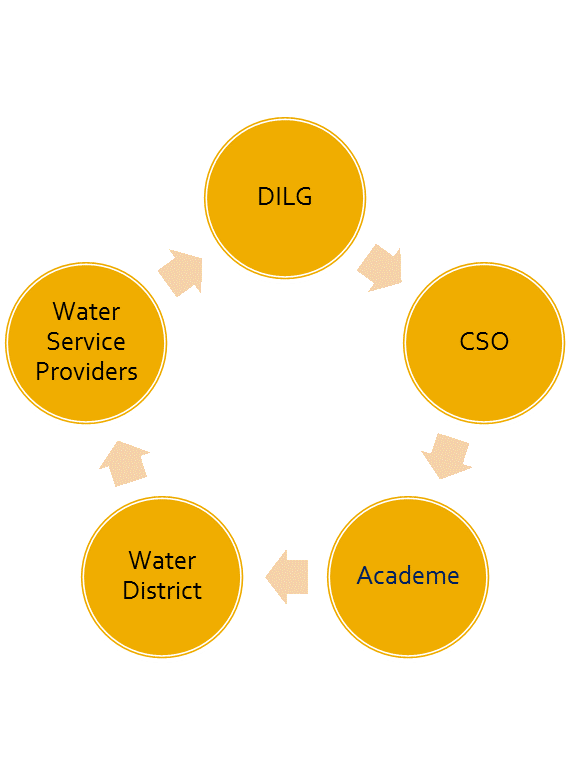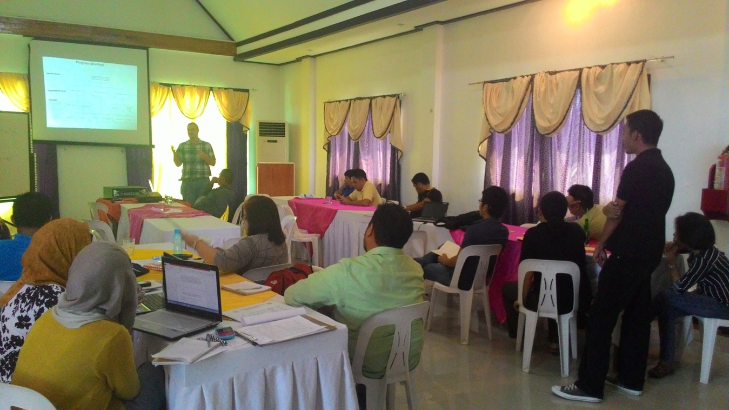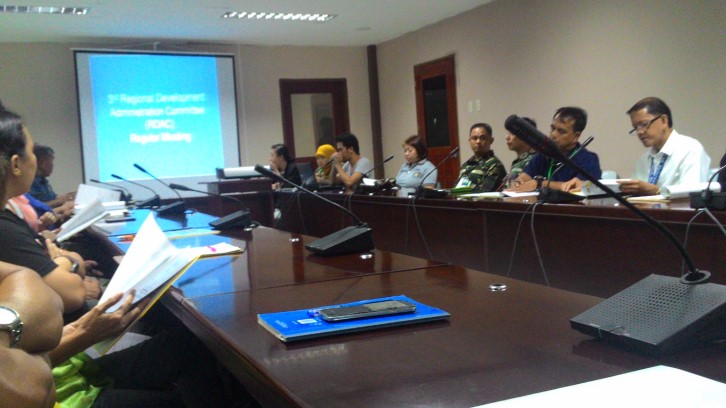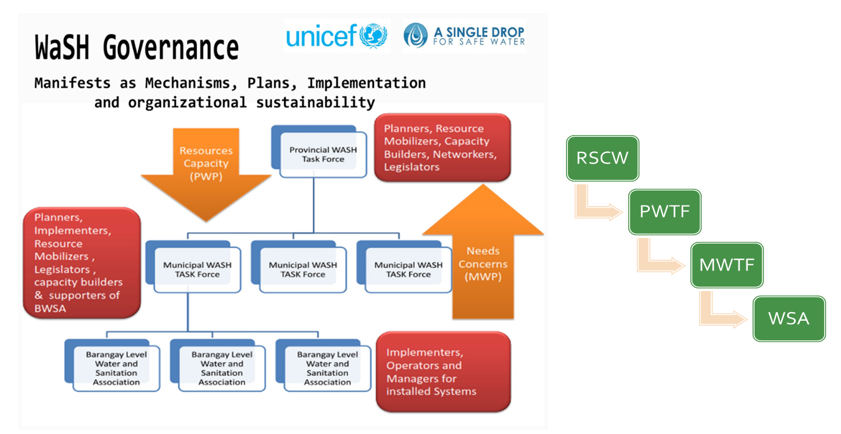THE WATSAN HUB

It is composed of at least three cooperating institutions, to be managed by the WATSAN Regional Hub Coordinating Council, composed of the heads of the member institutions. Its lead agency is the Department of Interior and Local Government (DILG). It is an effort of the government to harness and maximize local resources through the availability and willingness of experts, trainers and facilitators who would help DILG in capacitating waterless municipalities in the operation and management of their water supply and sanitation services under the Sagana at Ligtas na Tubig (SALINTUBIG) Program. It operates in the principle that “Water is a RIGHT. Water is LIFE. Without water life is FUTILE.”
HOW WAS ASDSW INVOLVED IN WATSAN HUB FORMATION IN ARMM?
ASDSW and DILG National office have been coordinating for some years now with regards to their program and activities and sharing of information on WaSH governance, noting the comparison between DILG’s MW4SP approach and ASDSW’s governance model. DILG became aware of ASDSW’s extensive WaSH projects implemented in Mindanao and suggested for ASDSW to join the WatSan Hub in ARMM.Thus, in 2014, ASDSW applied as WatSan hub member in ARMM at the DILG National Office.
Following ASDSW’s WatSan hub application, coordination and follow through activities were conducted in ARMM. It was learned that WatSan hub in ARMM was formed with only two (2) members: the WAO water district and Marawi State University. ASDSW would be the 3rd potential member. During this period, the WatSan hub is not yet very functional.
May 27, 2015- DILG-ARMM and ASDSW spearheaded a convergence meeting with potential members, advocating the functionality of the WatSan Hub in ARMM and building partnerships among WaSH implementers. The meeting was held in Cotabato City and attended by representatives from the Academe, CSOs, Service providers, government line agencies, UNICEF and other NGOs. There were sharing of specializations, programs and activities implemented in their respective covered areas among the participants. At the conclusion of the meeting, the DILG invited interested organizations to submit application for WATSAN hub membership. However, several months passed but no other organizations submitted an application.

Following the convergence meeting and the continuous coordination between ASDSW and DILG regarding issues and concerns on WaSH implementation in Mindanao, it was decided to raise the issue, specifically on Hub formation to the ARMM Regional Planning and development Office (RPDO). So, in August 6, 2015, the matter was presented to the RPDO during their regular meeting. Also in attendance during this meeting were representatives from UNICEF, ASDSW, DILG, ACF, IOM, GIZ, CRS, KFI, CFSI and CEMILARDEF.
During this coordination meeting with DILG and RPDO, several realizations were acknowledged:
- Lack of a regional structure that shall oversee implementation of WATSAN projects in the region. DPWH has so many projects being implemented in ARMM but are not coordinated with DILG.
- Local task forces are not sustainable for the purpose of strengthening and institutionalizing the WatSan hub.
- Water projects fail due to lack of accountability and knowledge in proper operation and management of the installed projects
- WatSan hub is not functional and not part of the government organization under the REDPB.

With these realizations, DILG suggested the creation of the sub-committee within the Regional Executive Development and Planning Board (REDPB) under the umbrella of the Regional Development Administrative Committee for it to be institutionalized and recognized within the ARMM structure. There are several agreements gained during the RPDO meeting:
- Member composition of the WatSan hub committee was set: Government agencies were identified as members and NGOs were identified as project partners.
- After the RPDO meeting, DILG will meet with prospective members, and ASDSW/UNICEF will meet with prospective partners to: – explain the plan to form a regional sub-committee for WaSH; and – conduct inventory of WaSH projects in ARMM
- Motion to create the Regional sub-committee on WaSH, and Motion to make the sub-committee a part of the ARMM government structure making it more sustainable, and the proposal to elevate the motions to the Regional Development Administration Committee (RDAC) for adoption and endorsement to the REDPB.
Separate meetings with prospective members and partners were conducted to generate information and mapping of WaSH projects in ARMM, and to generate consensus for the creation of the WatSan regional sub-committee. Results of these meetings are affirmative.
On September 10, 2015, the creation of RSCW was presented to the member of the REDPB. As a result, the Board passed a resolution approving the creation of RSCWS under the supervision of the RDAC, and on October 19, 2015 – the ARMM REDPB finally approved the creation of RSCW with the following composition:

Chair : Office of the Regional Governor
Co-Chair : DILG-ARMM
Secretariat : DILG-ARMM
Members : DOH, DepEd, DPWH, DAR, DSWD, DAF, DENR, DOST, RPDO, HLURB and BPI
Partner Agencies :UNICEF, ASDSW, SC, Oxfam, MTB, CRS, MCWD, LGUs, USAID, WFP (on invitation basis)

The new structure of the REDPB showing RSCWS under the RDAC
The Regional Sub-committee on WaSH will serve as coordinating and monitoring body of DILG-ARMM that will oversee implementation of WatSan Projects in the region. It aims to achieve more coordinated efforts on the implementation of WatSan Projects and contribute to the Millennium Goal no.7 of ensuring environmental sustainability in ARMM. It will have specific functions as follows:
- Coordinate, monitor and evaluate WatSan projects in the region.
- Provide technical assistance, empower and capacitate LGUs.
- Create a pool of trainers.
- Facilitate the establishment of WatSan database
- Document best practices in WatSan development.
- Perform such related functions as may be authorized by the REDPB/RDAC
There are distinct function between the Regional WatSan Hub and the Regional Sub-committee on WaSH. The Regional WatSan Hub serves as the information hub for capacity development through seminar-workshops, coaching and mentoring and other relevant trainings for LGUs, Water Service Providers and community organizations, and the engagement of individual resource persons/consultants to assist in the preparation and delivery of the programs. On the other hand, the RSCW will serve in the formulation of policies and plans of the LGUs in water and sanitation sector and establish the policies and directions for the implementation of the program at the local level. This development is very significant, not just in WaSH development in the region but it strengthens the legitimacy of the ARMM because the change in the direction in the WaSH sectoral planning was set by the ARMM Regional government, making it a monumental move towards self-governance and precipitating development in the region.
This direction ties up with the ASDSW governance model which involves participation of the communities from the barangay to municipal to Provincial level, and in the case of ARMM, up to the Regional level of governance.

Along the line of harmonization with DILG and ASDSW program, ASDSW is striving for the program outputs to fit in with DILG’s Human rights-Based WatSan governance approach. Projects developed in WaSH planning facilitated by ASDSW can be submitted by LGUs for SALINTUBIG or GPBP funding.
DILG is actively trying to implement “Ring Fencing with 130 organizations oriented and 3 implemented. ASDSW facilitates LGU training on ring fencing. It maybe possible for ASDSW to bid on capacity development work. The DILG, through the SDGF PRO-WATER Program may tap ASDSW as resource speakers for various activities and DILG may tap the expertise of the Hub members to consult and be paid by LGUs for development capacity.










